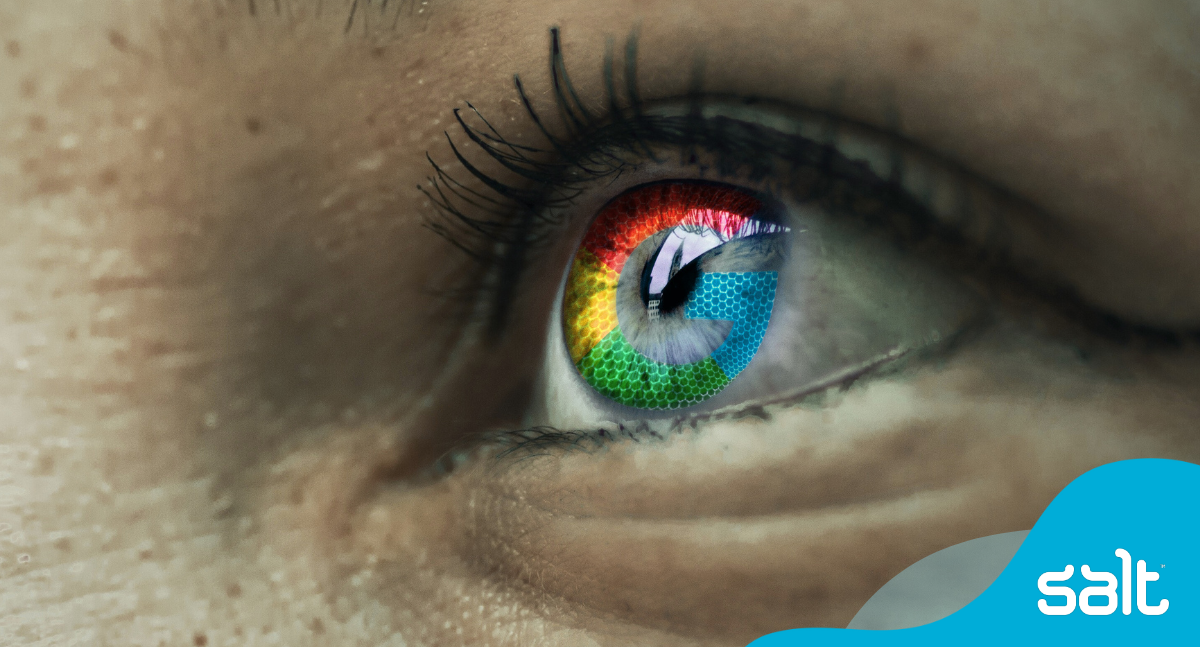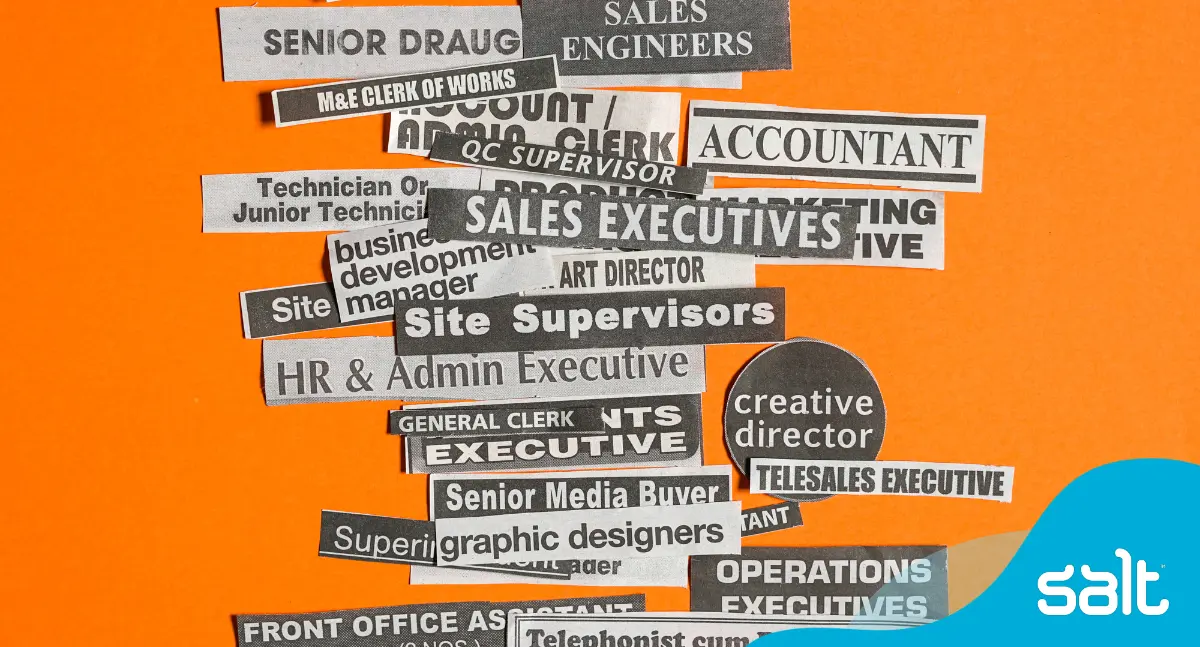
Many of the traits employers and hiring managers are looking for – innovation, creativity, analysis – are ones that Neurodiverse candidates possess in spades.
Everyone benefits from a more inclusive workplace – it raises employee well-being and retention – but in times of skill shortage and such a competitive job market, many don’t realise the impact of Neurodiverse inclusive hiring on their bottom line.
Listen to Anton and Natasya on Salt’s Creating Futures podcast!
Co-founders of Divergent Thinking, Anton and Natasya, share how Neurodiverse sensitive hiring and workplace culture benefit businesses.
Anton Ashcroft is a registered psychologist with considerable experience right across the corporate sector, forensic sector, clinical sector, as well as working within the prison environment. He’s researched and developed programs that have delivered transformative and lasting change to individuals. His son was diagnosed with Asperger’s and autism in 2019.
Natasya Jones is passionate about normalizing differently wired brains by partnering with individuals and organizations to understand, support and harness the power of true diversity. Her goal is to normalize and celebrate neurodiversity in New Zealand. Her son was diagnosed with ADHD and Asperger’s in 2014 and in the beginning of 2020, Natasya herself was diagnosed with ADHD, with dyslexic traits.
It’s time to do things differently
Neurodiverse graduates who have amazing talents are often either unemployed or under employed, due in large part to traditional recruitment methods.
They’re excluded on the basis of their deficits and lack of awareness of Neurodiverse abilities. In a time where talent is hard to come by – it’s time start to do things differently and make the most of this amazing talent pool.
DivergenThinking is helping organisations start to recruit, onboard and engage through a Neurodiverse lens, to attract new talent as well as to support Neurodiversity already present in their team.
Being inclusive of neurodiversity & Neurodiversity increases productivity, innovation therefore the bottom line.
Natasya: International data makes a really strong case for maximizing the power of neurodiversity within a psychologically safe environment.
When maximised and properly utilized, integrated neurodiversity means organisations are:
- 2x as likely to meet or exceed financial targets
- 3x as likely to be high performing
- 6x more likely to be innovative and agile
- 8x more likely to achieve better business outcomes.
JP Morgan Chase completed a study over 4 years with autistic employees. They found people on the spectrum are highly focused and less distracted, and the data was very compelling:
“People on the spectrum are highly focused and less distractedby social interactions. Our autistic employees achieve, on average, 48% to 140% more work than their typical colleagues, depending on the roles”.
2018, Executive Director & Head of Autism at Work
Being inclusive of neurodiversity also has amazing employee outcomes for businesses – because it enhances employee engagement, retention and mental wellbeing. Learning how our brains work, our strengths and challenges and what triggers us is also mental wellbeing 101.
Every brain is neurodiverse with a little ‘n’
Natasya: How our brains are wired impacts on how we process and experience the world around us. Different thinking and different emotions drives different types of behaviour.
Anton: Everyone’s brain wiring comes from learnt experiences: what we are born with, our genetics and how we’ve developed over time.
Even though we think we all live in the same world, we don’t. We all live in our world. We filter the world all the time based on our brain wiring.
So always check you’re on the same page – and don’t make assumptions about what other people are thinking and thinking that they’re seeing the same thing as you.
Natasya: Ultimately, there is no “normal” brain wiring. We all have different brains and are neurodiverse with a little n.
However, Neurodiversity with a big N, which includes Attention Deficit Disorder (ADD), Attention Deficit Hyperactivity Disorder (ADHD), Autism, Dyslexia, OCD and many more, which do mean thinking and making decisions differently.
Neurodiverse brains can have superpowers or strengths, as well as challenges. People don’t realize what those strengths are, and then get caught up in what we see, and unconscious bias.
Bias in recruitment: we recruit people who are like us
Anton: What we often do when we’re in a recruitment setting is we recruit people who are like us. We’re attracted to people who behave in a way that we see is familiar to us or useful from our worldview.
So, we can often do is discount people, like my son, who don’t present in that traditional expected way, or someone who may ‘seem’ scruffy at an interview or vague, may not look you in the eye, have a limp handshake or and who make us feel uncomfortable.
That confirmation bias means missing out on amazing skills that in the right location with the right support can really enhance productivity and innovation for an organization.
You’re also decreasing your candidate and skills pool – in a competitive job market. If you’re looking to hire individuals with skills like productivity and innovation – being inclusive to neurodiverse candidates means a much bigger and much more productive and innovative candidate pool.
A very quick introduction to the neuroscience of the brain
Anton: While this introduction is quick and simplified, the models we’ve shared below are a very, very useful way of conceptualizing how people make decisions and how they tend to process the world. These make the strengths associated with different brains clear, and this introduction to how the human brain works will help explain the theory underlying the following models.
The prefrontal cortex (PFC) is the evolutionarily new part of the brain. It’s the part of the brain that makes us clever. It is where the executive function sits.
It enables us to process the world:
- to problem solve
- to lay down memories
- to emotionally self-control
- to make predictions about the future and reflect on the past.
It’s what enables us to make rational, reasonable thinking based decisions.
Sitting underneath in the middle of the brain is what’s called the limbic brain, which has two main functions:
- The reward and pleasure centre: our need for immediate gratification.
- The fight, flight, or freeze response: when we are put in danger or in threat in some way, we respond either by moving towards that threat, moving away from the threat, or just freezing and thinking, “Okay, I don’t want do anything just in case I do it wrong.”
If you’ve ever been to the supermarket hungry, then you will understand the tension that can arise sometimes between the prefrontal cortex processing and the limbic brain. You might go into the shop thinking, “I really ought to have salad”, and your limbic brain is thinking, “But I love chocolate cake and I really need chocolate cake now.”
Your basket might be quite different when your stomach is empty and you’re responding with your limbic brain versus when your stomach is full and your rational brain has more control.
Listen to Anton and Natasya on Salt’s Creating Futures podcast!
Modelling neurodiversity: the medical model vs the social model
Natasya:
The medical model, or deficit model, sees the individual as the problem and focuses on the challenges of neurodiversity from the perspective of: how do we fix this? They need to be fixed. How do we make them normal?
The social model, or strengths-based model, focuses on the strengths of each of these differently wired brains and how we can maximise these and acknowledges we ‘all’ have challenges, as we are all human, we just need to learn how to manage or mitigate these.
The social model sees the social barriers as the problem and highlights how ignorant and inflexible organisations and schools (without inclusive procedures and practices) create obstacles to Neurodiverse individuals succeeding at school and work.
Prejudice, stereotyping and discrimination force many Neurodiverse people to mask to appear ‘normal’ and ‘fit in’, creating anxiety and leading to poor mental wellbeing, burnout and suicidal ideation. Sadly all too often, from the age of 7 – 8 years old.
There’s judgement and bias around terms like Autism, ADHD or depression – which is why the strengths-based social model is so powerful. It helps you understand what things people are driven by, how they learn and how they behave.
The strengths of Neurodiverse candidates and employees
Anton: Based on the DSM5 psychiatric manual and how it defines each of these presentations of Neurodiversity, we’ve briefly summarised the strengths for a workplace of a few of the more common Neurodiversities, to help understand the strengths these brain wirings can bring.
Note ADD has been excluded from the manual, but I find this label and the people I work with find this label incredibly helpful because it is quite different from ADHD.
Strengths-based model of ADD
ADD or attention deficit disorder is itself a bit of a myth. It’s not about attention, it’s about interest. Someone who has ADD can be hyper-focused and focus for hours on something that they love. But if they don’t like it, their limbic brain completely switches off and they have no drive to do anything.
This is why people with ADD are often seen as easily distracted, easily bored and frustrated, but they come with massive levels of creativity because their brain is often firing on all cylinders are making all these creative links.
Strengths-based model of ADHD
The ADHD brain, hyper attention deficit hyperactivity disorder, has the added component of you’re either on or you’re off.
If you’re on, you’ve got lots of energy, you’ve got lots of ideas, you’re very active, and you’re very innovative and solution focused. But on the flip side you can be very easily frustrated by other people’s lack of action, easily bored, and if people aren’t keeping up with your amazing ideas, it can make you feel very intolerant.
These are the types of people who are wonderful for your organization if you want your organization to disrupt the market or think about things in an innovative way, but don’t expect them to always turn up on time. Don’t expect them to do things that they find boring. Don’t expect them to toe the party line necessarily. They’ll often want to express exactly how they feel.
Strengths-based model of dyslexia
Dyslexia is part of this quadrant because that again comes very much with the visual sense of seeing the bigger picture, literally seeing the bigger picture. Richard Branson from Virgin, multi-billionaire, puts down his success precisely to his dyslexia because he could see the bigger picture in a way that other people couldn’t. He also had absolute conviction that what he was seeing was correct, and he backed himself.
Strengths-based model of Asperger’s and Autism
Individuals with Asperger’s or Autism may be incredibly gifted in some areas like analysis or memory or learning or information.
They will also have significant life interrupting challenges like difficulty understanding social cues or social awkwardness or social isolation or anxiety. They can be sensitive to light, sound, and touch. They may find strong foods or strong noises completely overwhelming.
If you are recruiting for these amazing talents, you also need to be able to be aware of what their challenges are so you can create an environment where they thrive.
Strengths-based model of OCD
OCD is attention to detail in its functional form. It becomes obsessive compulsive disorder when you’re engaging in repetitive behaviours that help you feel safe. This safety behaviour comes from the capacity to be able to pay great attention to detail – which has a lot of uses in workplace.
Strengths-based model of anxiety
Anxiety is often not regarded as a neurodiverse brain wiring problem; however, some people do have lifelong anxiety and this is a neurological condition. What it means is you’re super sensitive to the world, and you feel empathy and compassion from picking up on things that other people don’t pick up on.
Strengths-based model of depression
Depression in its functional form is being critical about the world around you. It only becomes dysfunctional when that then leads to helplessness or hopelessness or despair. Critical thinking, as you can imagine, is really, useful for an organization.
What the strengths-based model of Neurodiversity teaches us
Natasya:
For candidates, each of these different quadrants have different intellectual abilities. Knowing where your strengths lie, what drives you and how you make decisions can help you decide on a career or role that will suit your brain type and enable you to thrive.
For employers and recruiters, there are needed and sought after skills that come naturally to the Neurodiverse (with a big N). Skills like innovation and big picture thinking can come easily to someone with ADHD or Dyslexia – but they may struggle with time. Skills like being data driven can easily be paired with controlling traits. This is why it’s important to understand brain wiring and how the environment can support underused and overused strengths to result in productivity and engagement across whole teams.
Make the application process inclusive to all – and promote that fact.
There are different barriers depending on brain wiring for attracting and recruiting for a role. First, however, you need to educate your workforce and provide support tools to really create a Neurodiverse, equitable, and inclusive workplace fostering a sense of belonging for all employees.
Once you have done this you will be able to write job descriptions and ads that attract the brain wiring you are after and include you are “Neurodiverse friendly” and to let candidates know you want to help them be their best selves.
Develop assessments to ensure you are recruiting for the best role outcomes and onboard in a way that sets your new employee, team and business up for success.
Once you have done this you will be able to write job descriptions and ads that attract the best brain wiring, assess talent conscious of your biases and onboard new employees in the way that best suits their brain profile ensuring greater success from the get go. to ensure individual, team and organisational success. Once you have taken the Neurodiversity pledge you will be able to are after and include you are “Neurodiverse friendly” and to let candidates know you want to help them be their best selves.
Develop assessments to ensure you are recruiting for the best role outcomes and onboard in a way that sets your new employee, team and business up for success.
What DivergenThinking do
Inclusion doesn’t just stop with recruitment – it’s crucial that organisations invest in the right environment to support Neurodiversity and neurodiversity alike. This is what DivergenThinking specialise in.
Join the movement by taking Neurodiversity Pledge and commit your organisation and individuals to demonstrating safety, visibility and inclusion of Neurodiverse individuals in the community and workplace.
The Neurodiversity commitment involves educating your workforce about neurodiversity with both a little and big N while creating ‘true’ psychological safety, so you can ‘truly’ be informed and inclusive. You’re then able to include Neurodiversity in your strategy, goals, procedures, practices, to provide support networks and tools, communicate and normalise the fact that you already have Neurodiverse employees in your organisation to really create a Neurodiverse, equitable, and inclusive workplace fostering a sense of belonging for all employees.
- They have the NQ (Neurodiversity Intelligence) Stocktake, a powerful self-evaluation tool where you can accurately assess where your workplace is at in your Neurodiversity inclusion journey, generate invaluable data, and build a road map of how to get there.
- They have a framework for what good practise for a neurodiverse organisation looks like – and they can advise based on your existing tools and systems how to increase and maximise NQ (Neurodiverse Intelligence) to see real results across your whole organisation.
- Their Clash of the Quadrants program helps individuals and teams understand different types of brain wiring and communication, counter biases and work more innovatively and productively together.
- NQ Recruitment Master Class Accreditation Program is being launched this year to assist individuals and organisations develop Neurodiverse friendly systems to effectively recruit, onboard and engage Neurodiverse talent
No doubt you have heard of IQ and EQ, well DivergenThinking have developed a new NQ (Neurodiversity Intelligence)
This is a method of taking a neurodiverse lens to the whole employee life cycle to enhance employee wellbeing, retention, productivity and innovation, not just for individuals, but for teams and the whole organisations. This process consists of:
- Neuroscience based neurodiverse card sort process to identify most effective brain profiles for particular roles
- Supporting recruiters to be able to develop Neurodiverse sensitive adverts and interview processes
- Developing onboarding processes that are Neurodiverse sensitive and also good for everybody
- Helping leaders develop their own competence and confidence in supporting Neurodiverse employees in their team
Read more about DivergenThinking for organisations.


